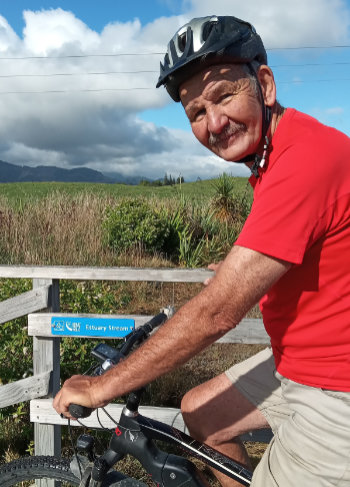Nelson trail-maker's award celebrates lifetime contribution to outdoor access

Bill Gilbertson
Cyclists and trampers in the Nelson region have better access to the outdoors thanks to Bill Gilbertson’s generosity of spirit and lifetime of hard work. His inspirational contributions to Nelson’s Great Taste Trail and access improvements to the Abel Tasman National Park are just two highlights from a long career in outdoor recreation and conservation.
Herenga ā Nuku Aotearoa, the Outdoor Access Commission, is acknowledging Gilbertson’s substantial contributions to public outdoor access in New Zealand with an Outdoor Access Champion award this Thursday.Chief executive officer, Ric Cullinane, commends Gilbertson’s enthusiastic and formidable career.
“Bill’s thoughtful leadership and hard graft bring people together and help get trails built,” says Cullinane.
Gilbertson has guided a plethora of environment-related organisations and initiatives. He was a conservation board member and national park management plan convenor for the West Coast and Tasman regions. He has provided leadership for Forest & Bird and the Forest Stewardship Council and has liaised with organisations including Federated Mountain Clubs (FMC) and the Department of Conservation (DOC).
He co-founded the Nelson Tasman Trails Trust in 2009 after moving to Nelson from the West Coast in 2000 and getting into biking with his son. He was looking for potential long-distance biking trails in the region.
“It was more from a transport point of view that I was looking. Sure recreation, but more about ‘Let's get safe places for bikes to go’,” he says. In 2008, he formed a small group to investigate forming a cycle trail between Picton and Murchison. The next year, Government announced its $50 million Great Rides funding opportunities.
“We formed the trust so that we could apply for that funding as an entity, and we applied for the Great Taste Trail and the Coppermine Trail,“ he says.
At 200km, the Great Taste Trail is the longest of the 22 Great Rides and is the 4th most used – over 315,000 people rode on it during 2021, with over three-quarters of those riders from the Nelson Tasman region. The Picton–Murchison route and other routes around the region are still long-term goals.
Gilbertson is generous and consultative, working with a wide range of stakeholders, encouraging participation and empowering others. He also rolls up his sleeves and helps with practical work. Trust chair Gillian Wratt says, “Without Bill’s enthusiasm and tenacity, it would have been hard to get the trail to where it is today”.
Another highlight of Gilbertson’s career was leading a successful initiative to remove Great Walk hut fees for under-18s.
“It started around a campfire, basically. We were sitting around with families, and we said, ‘This is getting too expensive’. And so I said, ‘Well, why don't I sort of start something off?’. And it was just the right time. Chris Carter, the Minister of Conservation at the time, said, ‘Let's go for it’. FMC came in and helped, of course. They supported it totally.”
Gilbertson is a strong believer in tempering public access with protection and management. During his time on the Nelson Marlborough Conservation Board, he addressed issues in the Abel Tasman National Park, where beaches on its great walk were under strain.
“It was more or less open slather, because there was no control over the foreshore. So the first thing was to say, ‘Yes, beautiful place to go, lovely beaches and everything, but we have to control the numbers, and we have to control what people are doing’,” says Gilbertson.
Through negotiation with operators and landowners, the foreshore came under DOC control and restrictions on numbers and landing places were established.
“One of the things that I've always emphasised is this balance between conservation and recreation, and I enjoy the challenge of getting people with opposing opinions to agree on a solution,” says Gilbertson.
He used similar skills to develop an access accord for mountain bikes in national parks, liaising with FMC in 2002. It was controversial, requiring a change to the national parks policy. Gilbertson is quick to point out that not all national parks are suitable for biking, but he supports shared-use tracks where they are well designed.
“There will always be some idiots who go too fast on a bike and cause problems. There are also some people who are very, very anti-bikes and don't want them anywhere. Generally, 98% of the people are good, but there's always a 2% that cause conflict issues. And I just think that's a reflection of society. We've all got to live together somewhere.”
Living together and living lightly on the planet are values that attract Gilbertson to cycling, and he’s a great advocate for cycling as active transport and recreation. As he says,
“It’s a method of transport that keeps you healthy, and it’s just so much fun for people. We need to get out of our cars. And we need to get into active transport. I mean, that's really where it's at, for me. I fear for the planet in terms of our carbon usage, and here's one way we can reduce it.”

